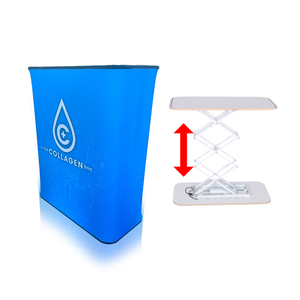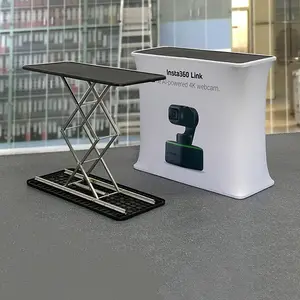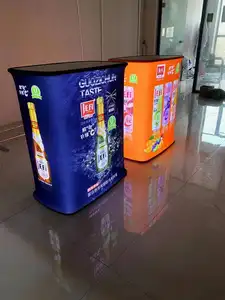
All categories
Featured selections
Trade Assurance
Buyer Central
Help Center
Get the app
Become a supplier

(3153 products available)








































According to the product categorization, trade show tables are divided into several types. Commercial buyers should select a table type based on their intended use and desired aesthetic. Here is a detailed overview of the most popular tables, as well as their pros and cons, depending on style and functionality.
These trade show booth tables are comfortable, functional, and reliable. Conventional tables are ideal for placing promotional items and brochures, and they can be used as a seating area for potential clients. Dimensions range from 4 feet to 8 feet. They are constructed using plywood and have metal frames to support heavy models.
Pros:
Cons:
Also known as a 'kitchen-style' booth table, this form of table has an open base with no drawers or panels. It is ideal for businesses wanting to use the table for displaying items. The open design can be more visually appealing.
Pros:
Cons:
Storage tables have shelves or cabinets under the top surface. They are ideal when more storage and displaying surfaces is required. Storage tables enable users to stock extra goods, marketing literature, and promotional items without cluttering the booth space.
Pros:
Cons:
Like the storage tables, Marley floor tile tables have a tough vinyl top that is perfect for high-traffic areas like booths. The tiles give a stylish look and make practical surfaces that easily clean spillages on the tabletop.
Pros:
Cons:
Buyers applying trade show tables for commercial use need to ensure that the tables can withstand intensive utilization. Considerations like table durability, as well as ease of cleaning and transport, become even more important. Here are the places where the tables can be used most effectively.
Exhibition attendees set up the tables as the exhibition areas, including trade shows, are the place where these tables shine. The trade show tables offer a designated place for brochures, promotional gifts, and product samples. This encouraged people to stop and engage at the booth.
Vendor and representative tables are also applied throughout professional conventions. They are used to reflect a brand's personality while establishing connections with the attendees. The organization aspect that comes with storage tables is a big plus in the busy convention environments.
In workshops and training sessions, tables provide a space where participants can work on projects or take notes. Tables with storage are especially useful in workshops that require materials or supplies. The tables are applied in corporate training events, which are often place-intensive and require robust furniture.
At employment fairs, potential applicants approach hiring managers and get information about employment opportunities. Trade show tables serve as a tool for employers to place all desirable job resources where applicants can get them easily.
Promotional activities are planned as a means of advertising sales or new product lines. Trade show tables can be used to hold promotional materials so that prospective customers can easily get them. The sturdy build of most tables makes them ideal for holding things like food and beverages during the promotion.
The long function and practicality of trade show tables are supported by certain features and specifications. Additionally, understanding the features avoids the selection of tables with unsuitable features for one's business.
Tabletop size and material
The tabletop of a trade show booth table comes in different sizes, depending on the type of event. In horizontal orientation, they can be anywhere between 4 and 8 feet long and over 2 feet wide. Materials range from plywood to vinyl laminate.
Leg type
It can be divided into three main types: collapsible/portable legs, fixed legs, and pedestal bases. Collapsible or portable legs make the table easy to transport and store. Fixed legs provide stability but will not allow flexibility in the positioning. A pedestal base design is attractive, offering better leg space to the users.
Weight capacity
Most trade show tables have a standard capacity of up to 200 kilograms. This can, however, vary from one table to another, depending on the material used. Exhibitors need to check the specifications and avoid overloading a table.
Finishes
Finishes also go a long way in determining the look or feel of a table. Details like edge banding, which protects the core material and gives a smooth finish, make tables look sophisticated. Lamination, on the other hand, makes the table a bit more rugged and waterproof.
Choose the ideal location
The most visible place is preferred when setting up the table. Attendees should approach the table without any obstacles. Also, ensure that there is no overhead power source or duct that may interfere with ceiling displays.
Prepare the space
Clean the area where the table will be set up. Remove any obstruction that might be in the place. Also, measure the space to confirm that the booth table will comfortably fit without being cramped.
Set up the table
Begin by attaching the legs to the tabletop if the table is collapsible and the legs need to be attached. Ensure the table is sturdy.
Arrange elements on the table
Place a tablecloth or cover on the table, if any. It should fit well and be wrinkle-free. Added other items like products, brochures, and props. Arrange them in a way that there is still some space for visitors to interact freely.
Cleaning
Daily or event-by-event cleaning is recommended for trade show tables. Use a soft, damp cloth and mild soap for general cleaning. It is important not to use harsh chemicals that may corrode or stain the finish on the tabletop.
Inspection
Conduct regular inspections to identify damaged parts, such as screws or legs. Look for any wobbling signs or instability. Catching small problems early on will prevent them from becoming bigger problems later.
Repairs
This will involve replacing damaged parts such as screws or leg supports and repairing tables with collapsible legs by ensuring the hinges are tightly fastened.
Protection
Avoid placing spiky objects like knives or high-heeled shoes directly on the tabletop to prevent cuts or scratches. Use covers or pads on areas vulnerable to damage.
One of the most important pieces of equipment for trade show participants is the trade show table, hence the need to choose wisely. The right table can help create an inviting booth, and several factors influence its selection.
Considering the following factors will help buyers select a trade show booth table that meets both functional and aesthetic requirements.
The main use(s) of the table should be the primary consideration in determining its features. Choose a tabletop size that provides enough space and an appropriate height for the activities. Tables with collapsible legs are good choices where space is a big constraint.
Choice of color schemes and designs will determine whether the table fits well within the desired booth appearance. For more appealing finishes, prefer tables with laminates or edge banding. There is also a need to judge the design of the table from a distance so as to have a clear evaluation of its marketing potential.
Materials should be evaluated based on their impact on the function and life of a table. Vinyl and laminates are damage-resistant for applications where the table will be heavily used. Materials such as particleboards may be used in modern applications but also degrade faster.
Mobility is, however, not a consideration when the table will be placed permanently within the exhibit area. But when the movement is to be frequent, go for tables where the legs can be collapsed for easy storage and transport.
Develop a budget for the type of show or event one is attending, as this will determine how to set the cost. In general, portable tables are more expensive than the regular ones — investing in them pay off by reducing the setup and takedown time.
A1: The appropriate size for a tabletop relies on the available space and the nature of the products offered. However, the most popular size is often an 8-foot long table, as it provides ample space without feeling overcrowded.
A2: Yes, there are many collapsible tables that are ideal for traders who attend multiple shows. Such tables are light and easy to pack, saving space and effort during transportation.
A3: Laminate and vinyl-finished tables are easy to clean but may require gentle cleaning agents. Using table covers will additionally protect the surface from spills.
A4: When put into the right design and function, trade show tables provide an organized area for displays and engagements in activities. A well-placed, appealing table can invite more visitors to stop and interact with the booth.
A5: Trade show tables are designed with events in mind — they are often more varied in style, easier to transport, and made to withstand greater use than regular office furniture.